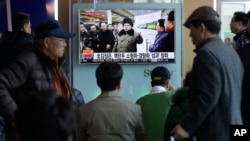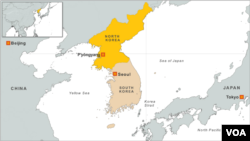North Korean leader Kim Jong Un said Wednesday his country has developed miniature nuclear warheads that can fit on a ballistic missile.
While such bellicose claims are not new from the reclusive nation, this is the first time the North Korean leader has made such an assertion.
The state-run Korean Central News Agency (KCNA) reported Wednesday that Kim met with nuclear scientists and technicians who briefed him on "research conducted to tip various types of tactical and strategic ballistic missiles with nuclear warheads."
The agency also published photographs that appeared to show the North Korean leader visiting a facility where the warheads were made.
The photos could not be independently confirmed and a number of military analysts have said they doubt the North's claim.
U.S. military leaders have said in the past that North Korea has the right connections and technology to develop a miniaturized nuclear device, but it has yet to demonstrate such capability.
North Korean boasts about its nuclear capability support Pyongyang's intensified efforts to counter world condemnation following the country's fourth nuclear test and recent long-range rocket launch.
But its public diplomacy outreach has done a very poor job of defending itself against such vilification. After the U.N. imposed new tough sanctions last week on the reclusive nation, its military responded by firing projectiles into the sea. Kim also threatened to conduct a pre-emptive nuclear strike against South Korea and the United States.
Last month, North Korean authorities continued a longstanding practice of forcing detained foreigners to make carefully staged public confessions. This time they made an American student admit that his attempt to steal a sign in a hotel was part of a sinister U.S. plot.
And the North Korean media regularly makes obscene, graphic and derogatory comments about U.S. and South Korean leaders.
History of provocation
Observers have long debated what motivates Pyongyang's provocative rhetoric.
Ko Yu-hwan, professor of North Korean studies at Seoul's Dongguk University, says recent provocations are a response to current events.
“As South Korea and the U.S. are conducting a large-scale military exercise involving training aimed at striking the North Korean leadership, Kim Jong Un is trying to send a message that his country has nuclear weapons and show his country’s nuclear capability as a deterrence,” he said.
Chang Yong-seok, senior researcher at Seoul National University’s Institute for Peace and Unification Studies, said Pyongyang's claims to miniaturized nuclear devices "sends a message to the world that sanctions will not solve the issue," while demanding that the international community accept its way of solving differences.
But Chon Hyun-joon of the Institute for Northeast Asia Peace and Cooperation Studies said Pyongyang's rhetoric may be targeting it people within in its own borders.
“In an attempt to keep its citizens from being agitated by pressure from the U.S., Kim Jong Un is seeking internal solidarity by vowing a strong retaliation against the pressure,” he said.
Brian Myers, who examined North Korean propaganda in his 2010 book, The Cleanest Race: How North Koreans See Themselves and Why it Matters, said Pyongyang's confrontational public relations style can be traced back to founding leader Kim Il Sung, who was installed by the Soviet Union at the end of World War II.
"Kim Il Sung always said the Korean people should not be afraid of the Yankees. They should realize that the Yankees can be beaten and these images serve that end," said Myers, who is also an associate professor of International Studies at Dongseo University in South Korea.
North Korea, he said, uses threats and belligerent language as a way to engage Washington.
"This rhetoric is the North's way of saying to Washington, You guys better keep us on the front burner because we are just as ready to fight and die as your enemies in the Middle East are," he said.
Rhetoric
In recent years North Korea's rhetoric has become more harsh and bellicose in part because more information from the outside world is filtering into the once tightly controlled and isolated state.
"In the old days the regime could make very peaceful noises to the outside world and very bellicose racist noises in what I call megaphone propaganda, the sort of thing that North Koreans get in their farms and factories," said Myers. "But now as more and more North Koreans have access to outside sources of information, the regime is under much more pressure to speak in one voice. And that means making much the same warlike and often racist noises in export propaganda that it has always made on the home front."
Read transcript of Brian Padden's interview with Brian Myers
There is a method to North Korea's warlike rhetoric. Internally it is meant to boost a sense of national pride. Externally it is meant to increase anti-American extremist sentiment in South Korea and elsewhere.
It has also worked in the past to force concessions from the West.
Diplomacy
But, Myers said, while this type of diplomacy may seem to many as amateurish and counterproductive, it accurately reflects the uncompromising position of the political and military leaders in Kim Jong Un's inner circle of power.
"Those are ultra nationalists who are genuinely outraged by the presence of American troops in South Korea, who remain genuinely committed to reunifying the peninsula. And this is the problem with ultra-nationalists everywhere, is that it's very difficult for them to put themselves in the shoes of other nations, of other races and has great difficulty presenting itself in a sophisticated way to them," he said.
This report was produced in collaboration with VOA's Korean Service.












